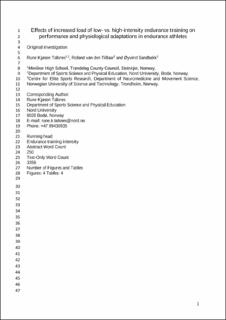| dc.description.abstract | Purpose: To compare the effects of increased load of low- versus high-intensity endurance training on performance and physiological adaptations in well-trained endurance athletes. Methods: Following an 8-week preintervention period, 51 (36 men and 15 women) junior cross-country skiers and biathletes were randomly allocated into a low-intensity (LIG, n = 26) or high-intensity training group (HIG, n = 25) for an 8-week intervention period, load balanced using the overall training impulse score. Both groups performed an uphill running time trial and were assessed for laboratory performance and physiological profiling in treadmill running and roller-ski skating preintervention and postintervention. Results: Preintervention to postintervention changes in running time trial did not differ between groups (P = .44), with significant improvements in HIG (−2.3% [3.2%], P = .01) but not in LIG (−1.5% [2.9%], P = .20). There were no differences between groups in peak speed changes when incremental running and roller-ski skating to exhaustion (P = .30 and P = .20, respectively), with both modes being significantly improved in HIG (2.2% [3.1%] and 2.5% [3.4%], both P < .01) and in roller-ski skating for LIG (1.5% [2.4%], P < .01). There was a between-group difference in running maximal oxygen uptake changes (P = .04), tending to improve in HIG (3.0% [6.4%], P = .09) but not in LIG (−0.7% [4.6%], P = .25). Changes in roller-ski skating peak oxygen uptake differed between groups (P = .02), with significant improvements in HIG (3.6% [5.4%], P = .01) but not in LIG (−0.1% [0.17%], P = .62). Conclusion: There was no significant difference in performance adaptations between increased load of low- versus high-intensity training in well-trained endurance athletes, although both methods improved performance. However, increased load of high-intensity training elicited better maximal oxygen uptake adaptations compared to increased load of low-intensity training. | en_US |
